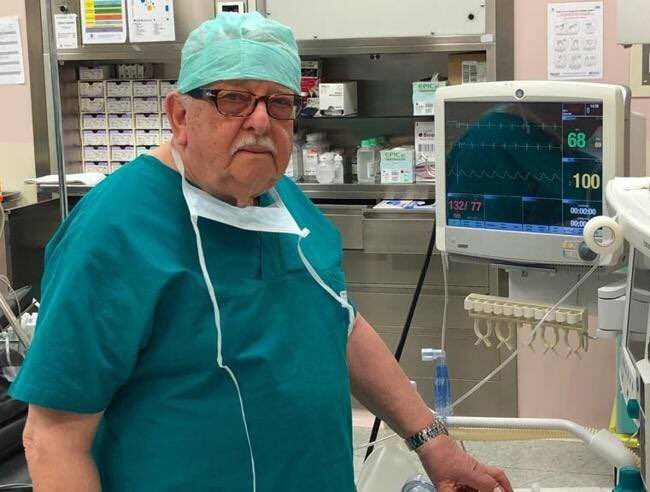Italian doctors on the front lines of the novel coronavirus crisis say they feel like they are living in a war zone, where they have to make quick triage decisions – who to save, who is beyond saving. They watch dying patients send their last messages to their family and deal with their own extreme physical and mental fatigue working in overburdened hospitals.
“Every day is a battle,” said Sergio Cattaneo, 45, a specialist in cardiac surgery anesthesia and resuscitation at the Spedali Civili Hospital in Brescia in Lombardia, one of the Italian cities hardest hit by the outbreak of coronavirus and its resulting COVID-19 disease.
Farther south in Perugia, the capital of the central Italian region of Umbria, Paolo Groff, 55, Director of the Emergency Department at Santa Maria della Misericordia Hospital, spoke about the sheer sadness of watching gravely ill patients who are still conscious and aware of their ultimate fate. “They speak hardly at all because they are paralyzed with fear,” he says. “They are isolated and cannot see their families.”
Dr. Cattaneo and Dr. Groff say their hospitals’ intensive-care units are barely coping. There are not enough doctors and nurses, not enough life-saving ventilators, not enough protective gowns to shield them from the disease that is killing almost ten per cent of infected Italians.
COVID-19 is also killing some of their colleagues and infecting others. With over 5,000 medical professionals in quarantine, their valuable services are sorely missed. At Dr. Cattaneo’s hospital, two doctors went into intensive care; both recovered.
The regional health authorities have been begging retired doctors, nurses and medical technicians to report for work again and many have. A perfect example of the kind of people who are providing a ray of hope and light at the end of the tunnel is Dr. Giampiero Giron. A legendary figure in the world of Italian anesthesiology, the 85-year-old retired doctor has taken up the mantle in the fight against the virus outbreak. When asked if he would come out of retirement to assist in the medical crisis in Italy, he did not hesitate. He is back in the trenches, fighting to save lives.
Born in Padua in 1934, he has numerous degrees from the University of Padua and is a Professor Emeritus at the renowned university. Dr. Giron is the author of 705 publications in the field of anesthesiology, reanimation, intensive care, pain therapy, hyperbaric medicine and toxicology and was a member of the team that performed Italy’s first heart transplant in 1985. He has become something of a national hero since he has once again suited up in green scrubs, well aware that the coronavirus can be merciless for those in their 80s.
“They asked for my availability and I said yes,” he told the media. “When you decide to be a doctor in life, you get involved. I swore an oath. Afraid of getting sick? Then it is better not to be a doctor.”
Italians remain resolute, even upbeat, despite their fatigue, as they pull together to cheer their medical heroes from their balconies and try to prevent their hospitals from collapsing. Manufacturers who were making socks, cars and fashion items are now making, or are about to make, ventilators, face masks and sanitizing hand gel. “I am an optimist,” Dr. Cattaneo says. “We’ve seen a reduction in new patients and deaths in the last few days. But we definitely have a few more weeks of extreme pressure, at least.”
In spite of the fall in cases, the numbers remain grim. Italian COVID-19 fatalities have surpassed those of China. The vast majority of the dead were patients older than 70 with one or more underlying conditions, such as diabetes, hypertension and heart disease.
The month of March brought more than 10,000 deaths to the country, due to the virus. The worst day was March 27, which saw 919 succumb to COVID 19. By month’s end, the numbers were staggering.
There were 23,809 closed cases that resulted in 13,030 individuals who had recovered and were discharged (55%), while 10,779 of the cases had died. A 45% rate of mortality. The numbers were highly skewed towards the negative, due to the length of time for treatment.
For those who were currently infected at the end of March, the total was 73,880. Of those, 69,974 (95%) had mild symptoms, while 3,906 (5%) were in serious or critical condition.
The wealthy northern region of Lombardia, whose cities include Milan, Brescia and Bergamo, remain ground zero for the Italian coronavirus cases. The region has recorded more than half of the cases in Italy.
In much of the northern part of the country, ambulances have silenced their sirens so as not to alarm people, but then again, the empty roads also mean they move swiftly without the need for sirens. Dr. Cattaneo says the ICU at his Brescia hospital, similar to all hospitals, was unprepared for the onslaught of patients, which began at the start of March, a few days after Italian Prime Minister Giuseppe Conte placed 11 northern Italian towns into quarantine. The enormous Brescia hospital, with 1,000 beds, had just 29 ICU beds. As waves of patients arrived, more space was freed up by sending patients home who were waiting for elective surgery. Today, the hospital has 53 ICU beds for COVID-19 patients, with another 13 coming. But there are just eight ICU beds for non-COVID-19 patients. The whole hospital has essentially transformed itself into a coronavirus center. Most of the patients were on oxygen masks with the most serious cases on ventilators.
Dr. Cattaneo says that the stress on doctors, nurses and staff is enormous. In normal times, there is one nurse for every two ICU patients. But the rise in patient numbers, which has gone unmatched by a rise in hospital staff, means there is only one nurse for every three patients. “For four weeks, we have had no time off,” he said. “We are exhausted and we see so much death. This is heavy for us. We are very tired physically and mentally.”
He says he was grateful when a batch of Samsung tablets were donated to his hospital’s ICU. The patients use the small computers to record messages to their families, since they cannot visit them. For some, it is their last message. It is also a way for family members to see their loved ones who are in coma or have just passed.
In Umbria, a region with relatively few coronavirus infections, Dr. Groff’s hospital is nonetheless almost overwhelmed by new patients. He says 10 to 20 arrive every day. Almost all are senior citizens, though one patient was in his mid-20s. “We need more ventilators,” he says. “We need at least 20 more. They are sold out. This is a crisis for us.”
But neither Dr. Groff nor Dr. Cattaneo say the grueling and heartbreaking work has immobilized them or even slowed them down – they have vital jobs to do. “I am not depressed at all,” Dr. Groff said. “We’re just doing our work,” said Dr. Cattaneo.





